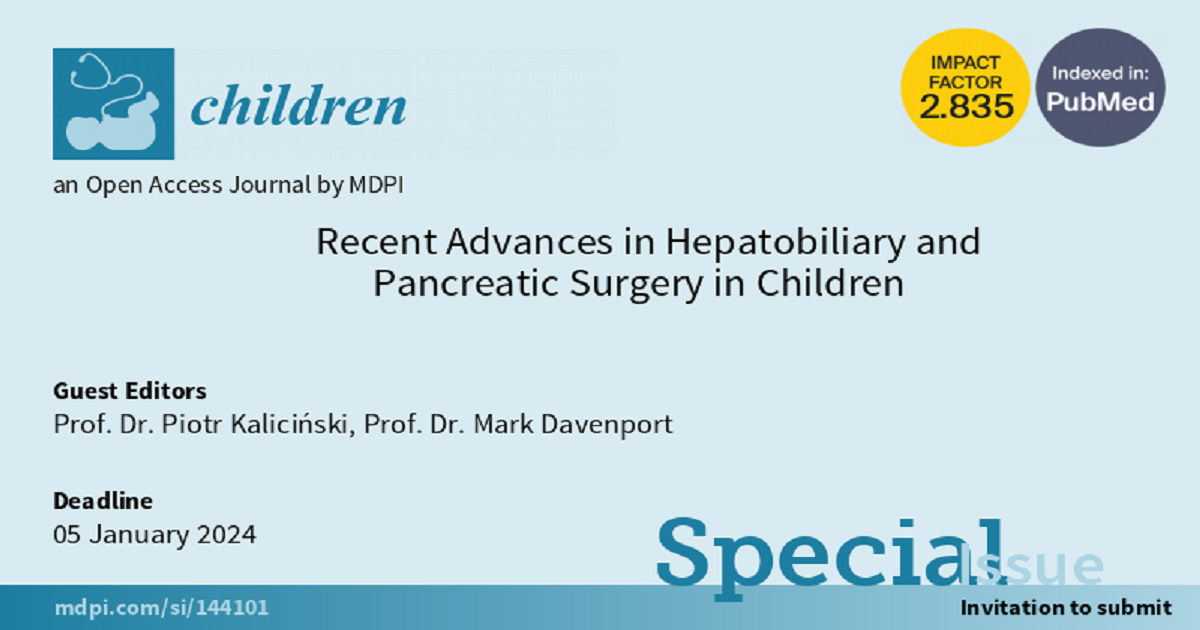Recent Advances in Hepatobiliary and Pancreatic Surgery in Children
A special issue of Children (ISSN 2227-9067). This special issue belongs to the section "Pediatric Surgery".
Deadline for manuscript submissions: closed (5 January 2024) | Viewed by 6753

Special Issue Editors
Interests: hepatobiliary surgery in children; gastrointestinal surgery in children; pediatric solid tumors; congenital malformations and neonatal surgery; abdominal organ transplantation in children (liver, kidney, intestine, multiorgan)
Special Issues, Collections and Topics in MDPI journals
Special Issue Information
Dear Colleagues,
Hepatobiliary and pancreatic surgery have always been considered the domain of general surgeons, but are becoming increasingly common in the practice of pediatric surgeons. We therefore encourage you to publish and share your experience in any aspect of hepatobiliary and pancreatic surgery in children, encouraging the exchange of knowledge among surgeons, as well as pediatricians, pediatric gastroenterologists, and oncologists. This Special Issue is open for papers on hepatobiliary and pancreatic trauma, congenital malformations, acquired diseases, inflammatory diseases, benign and malignant tumors as well as postsurgical complications including post-liver-transplantation problems. We invite papers on the use of minimally invasive surgical techniques including robotic surgery and radiological interventions, as well as intraoperative tools which enhance the safety and effectiveness of surgery.
Prof. Dr. Piotr Kaliciński
Prof. Dr. Mark Davenport
Guest Editors
Manuscript Submission Information
Manuscripts should be submitted online at www.mdpi.com by registering and logging in to this website. Once you are registered, click here to go to the submission form. Manuscripts can be submitted until the deadline. All submissions that pass pre-check are peer-reviewed. Accepted papers will be published continuously in the journal (as soon as accepted) and will be listed together on the special issue website. Research articles, review articles as well as short communications are invited. For planned papers, a title and short abstract (about 100 words) can be sent to the Editorial Office for announcement on this website.
Submitted manuscripts should not have been published previously, nor be under consideration for publication elsewhere (except conference proceedings papers). All manuscripts are thoroughly refereed through a single-blind peer-review process. A guide for authors and other relevant information for submission of manuscripts is available on the Instructions for Authors page. Children is an international peer-reviewed open access monthly journal published by MDPI.
Please visit the Instructions for Authors page before submitting a manuscript. The Article Processing Charge (APC) for publication in this open access journal is 2400 CHF (Swiss Francs). Submitted papers should be well formatted and use good English. Authors may use MDPI's English editing service prior to publication or during author revisions.
Keywords
- pediatric hepatobiliary diseases
- pediatric hepatobiliary surgery
- pediatric pancreatic diseases
- pediatric pancreatic surgery
- congenital hepatobiliary malformations
- hepatobiliary tumors in children
- pancreatic tumors in children
- pediatric hepatobiliary trauma
- pediatric pancreatic trauma
- minimally invasive surgery






